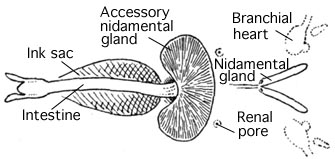ink sac on:
[Wikipedia]
[Google]
[Amazon]
 An ink sac is an anatomical feature that is found in many
An ink sac is an anatomical feature that is found in many
 An ink sac is an anatomical feature that is found in many
An ink sac is an anatomical feature that is found in many cephalopod
A cephalopod is any member of the molluscan Taxonomic rank, class Cephalopoda (Greek language, Greek plural , ; "head-feet") such as a squid, octopus, cuttlefish, or nautilus. These exclusively marine animals are characterized by bilateral symm ...
mollusk
Mollusca is a phylum of protostomic invertebrate animals, whose members are known as molluscs or mollusks (). Around 76,000 extant species of molluscs are recognized, making it the second-largest animal phylum after Arthropoda. The ...
s used to produce the defensive cephalopod ink
Cephalopod ink is a dark-coloured or luminous ink released into water by most species of cephalopod, usually as an escape mechanism. All cephalopods, with the exception of the Nautilidae and the Cirrina (deep-sea octopuses), are able to release ...
. With the exception of nocturnal and very deep water cephalopod
A cephalopod is any member of the molluscan Taxonomic rank, class Cephalopoda (Greek language, Greek plural , ; "head-feet") such as a squid, octopus, cuttlefish, or nautilus. These exclusively marine animals are characterized by bilateral symm ...
s, all Coleoidea (squid, octopus and cuttlefish) which dwell in light conditions have an ink sac, which can be used to expel a cloud of dark ink in order to confuse predators.
The ink sac is a muscular bag which originated as an extension of the hind gut; it is a modified hypobranchial gland The hypobranchial gland is a glandular structure which is part of the anatomy of many mollusks, including several different families of gastropods, and also many protobranch bivalves. This gland produces mucus as well as biologically active compou ...
.Nair, J.R., D. Pillai, S.M. Joseph, P. Gomathi, P.V. Senan & P.M. Sherief (2011). ''Indian Journal of Geo-Marine Sciences'' 40(1): 13–27. It lies beneath the gut and opens into the anus, into which its contents – almost pure melanin
Melanin (; ) is a family of biomolecules organized as oligomers or polymers, which among other functions provide the pigments of many organisms. Melanin pigments are produced in a specialized group of cells known as melanocytes.
There are ...
– can be squirted; its proximity to the base of the funnel means that the ink can be distributed by ejected water as the cephalopod uses its jet propulsion. The ejected cloud of melanin is bound by mucus
Mucus (, ) is a slippery aqueous secretion produced by, and covering, mucous membranes. It is typically produced from cells found in mucous glands, although it may also originate from mixed glands, which contain both Serous fluid, serous and muc ...
particles, so it forms a lump approximately the size and shape of the cephalopod, fixing the predator's attention while the mollusc itself makes a hasty escape.
References
Cephalopod zootomy {{cephalopod-stub